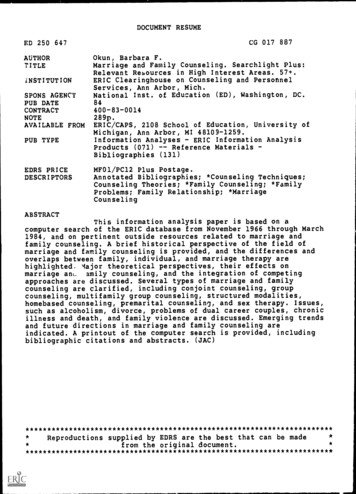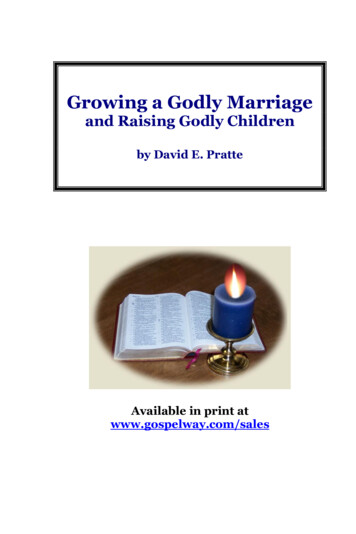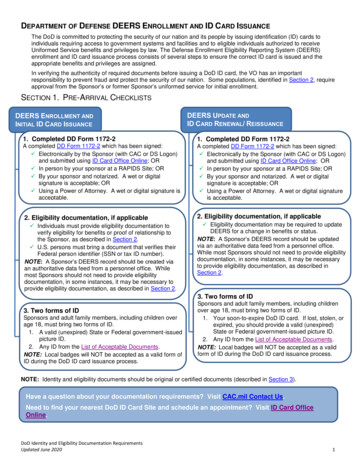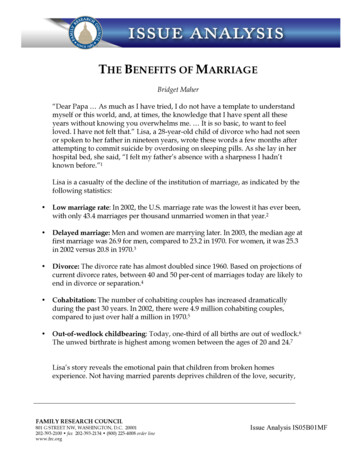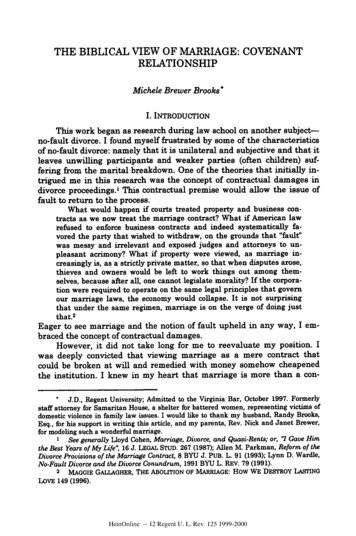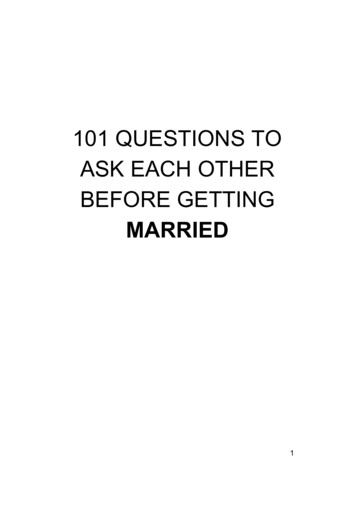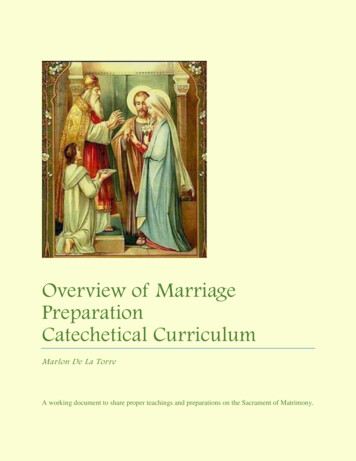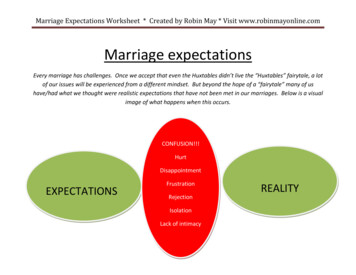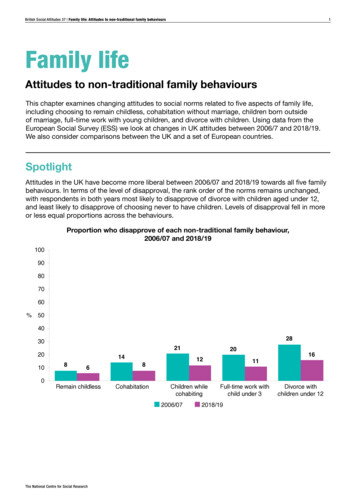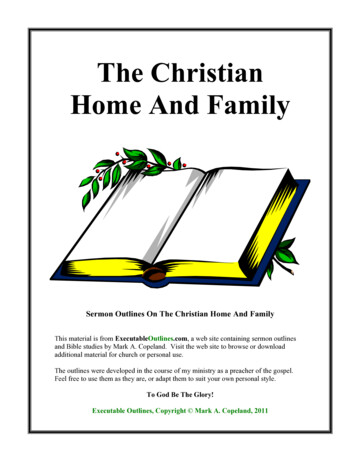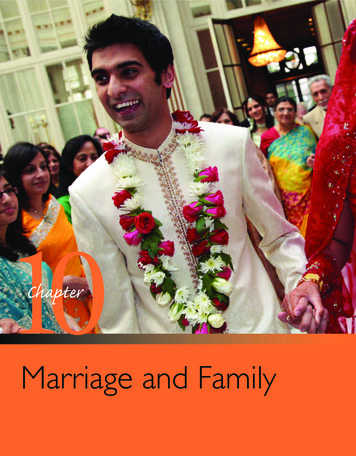
Transcription
10ChapterMarriage and Family
“LondonHold still. We’re going to be late,” said Sharonas she tried to put shoes on 2-year-old Michael,who kept squirming away.Finally succeeding with the shoes, Sharon turned to 4-year-oldBrittany, who was trying to pull a brush through her hair. “It’sstuck, Mom,” Brittany said.“Yes, he did,” Brittany“Well, no wonder. Justhow did you get gum in yoursaid, crossing her armshair? I don’t have time fordefiantly as she kickedthis, Brittany. We’ve got toher brother’s seat.leave.”Getting to the van fifteenminutes behind schedule, Sharon strapped the kids in, and thenherself. Just as she was about to pull away, she remembered that shehad not checked the fridge for messages.“Just a minute, kids. I’ll be right back.”Running into the house, she frantically searched for a notefrom Tom. She vaguely remembered him mumbling somethingabout being held over at work. She grabbed the Post-It and ranback to the van.“He’s picking on me,” complained Brittany when her motherclimbed back in.“Oh, shut up, Brittany. He’s only 2. He can’t pick on you.”“Yes, he did,” Brittany said, crossing her arms defiantly as shestretched out her foot to kick her brother’s seat.“Oh, no! How did Mikey get that smudge on his face? Didyou do that, Brit?”Brittany crossed her arms again, pushing out her lips in herclassic pouting pose.As Sharon drove to the day care center, she tried to calm herself. “Only two more days of work this week, and then the weekend. Then I can catch up on housework and have a little relaxedtime with the kids. And Tom can finally cut the grass and buy thegroceries,” she thought. “And maybe we’ll even have time to makelove. Boy, that’s been a long time.”At a traffic light, Sharon found time to read Tom’s note. “Oh,no. That’s what he meant. He has to work Saturday. Well, there gothose plans.”What Sharon didn’t know was that her boss had also made plansfor Sharon’s Saturday. And that their emergency Saturday babysitterwouldn’t be available. And that Michael was coming down with theflu. And that Brittany would follow next. And that . . .301
302Chapter 10polygyny a form of marriagein which men have more thanone wifepolyandry a form of marriagein which women have morethan one husbandfamily two or morepeople who considerthemselves related by blood,marriage, or adoptionM A R R I A G E A N D F A M I LY“There just isn’t enough time to get everything done!” Most of us have this complaint,but it is especially true for working parents of young children. Unlike parents in the past,today’s young parents find themselves without the support that used to be taken for granted:stay-at-home moms who provided stability to the neighborhood, husbands whose sole income was enough to support a wife and several children, a safe neighborhood where evensmall children could play outside, and grandmas who could pitch in during emergencies.Those days are gone, most likely forever. Today, more and more families are like Sharonand Tom’s. They are harried, working more but haunted by debt, and seeming to have lesstime for one another. In this chapter, we shall try to understand what is happening to theU.S. family and to families worldwide.household people who occupy the same housing unitnuclear family a family consisting of a husband, wife, andchild(ren)family of orientation thefamily in which a person growsupfamily of procreation thefamily formed when acouple’s first child is bornMarriage and Family in Global PerspectiveTo better understand U.S. patterns of marriage and family, let’s first look at how customsdiffer around the world. This will give us a context for interpreting our own experiencewith this vital social institution.What Is a Family?“What is a family, anyway?” asked William Sayres in an article on this topic. In posing thisquestion, he (1992) meant that although the family is so significant to humanity that itis universal—every human group in the world organizes its members in families—theworld’s cultures display so much variety that the term family is difficult to define. For example, although the Western world regards a family as a husband,wife, and children, other groups have family forms in which men havemore than one wife (polygyny) or women more than one husband(polyandry). How about the obvious? Can we define the family asthe approved group into which children are born? Then we would beoverlooking the Banaro of New Guinea. In this group, a youngwoman must give birth before she can marry—and she cannotmarry the father of her child (Murdock 1949).What if we were to define the family as the unit in which parentsare responsible for disciplining children and providing for theirmaterial needs? This, too, is not universal. Among the TrobriandIslanders, it is not the parents but the wife’s eldest brother who isresponsible for providing the children’s discipline and their food(Malinowski 1927).Such remarkable variety means that we have to settle for a broaddefinition. A family consists of people who consider themselves related by blood, marriage, or adoption. A household, in contrast, consists of people who occupy the same housing unit—a house,apartment, or other living quarters.We can classify families as nuclear (husband, wife, and children)and extended (including people such as grandparents, aunts, uncles,and cousins in addition to the nuclear unit). Sociologists also refer tothe family of orientation (the family in which an individual growsup) and the family of procreation (the family that is formed whena couple has its first child).Often one of the strongest family bonds is that ofmother–daughter. The young artist, an eleventh grader,wrote:“This painting expresses the way I feel about myfuture with my child. I want my child to be happy and Iwant her to love me the same way I love her. In that waywe will have a good relationship so that nobody will beable to take us apart. I wanted this picture to be alive;that is why I used a lot of bright colors.”What Is Marriage?We have the same problem here. For just about every element you mightregard as essential to marriage, some group has a different custom.Consider the sex of the bride and groom. Until recently, this wastaken-for-granted. Then in the 1980s and 1990s, several European
Marriage and Family in Global Perspectivecountries legalized same-sex marriages. In 2003, so did Canada, followed by several U.S.states. In 2008, California approved same-sex marriages, and a few months later bannedthem.Same-sex marriages sound so new, but when Columbus landed in the Americas, someNative American tribes were already practicing same-sex marriages. Through a ceremonycalled the berdache, a man or woman who wanted to be a member of the opposite sex wasofficially declared to have his or her sex changed. The “new” man or woman put on theclothing of the opposite sex, performed the tasks associated with his or her new sex, andwas allowed to marry.Even sexual relationships don’t universally characterize marriage. The Nayar of Malabarnever allow a bride and groom to have sex. After a three-day celebration of the marriage,they send the groom packing—and never allow him to see his bride again (La Barre 1954).This can be a little puzzling to figure out, but it works like this: The groom is “borrowed”from another tribe for the ceremony. Although the Nayar bride can’t have sex with her husband, after the marriage she can have approved lovers from her tribe. This system keepsfamily property intact—along matrilineal lines.At least one thing has to be universal in marriage—that the bride and groom are alive.So you would think. But even in such a basic matter we find an exception. On the LoessPlateau in China, if a man dies without a wife, his parents look for a dead woman to behis bride. After finding one—from parents willing to sell their dead unmarried daughter—the dead man and woman are married and then buried together. Happy that their son willhave intimacy in the afterlife, the parents throw a party to celebrate the marriage (Fremson2006). This is an ancient Chinese practice, and it used to be that the couple was buriedin a double coffin (Yao 2002).With such encompassing cultural variety, we can define marriage this way—a group’sapproved mating arrangements, usually marked by a ritual of some sort (the wedding) toindicate the couple’s new public status.marriage a group’sapproved matingarrangements, usuallymarked by a ritualof some sortCommon Cultural ThemesDespite this diversity, several common themes run through marriage and family. As Table 10.1illustrates, all societies use marriage and family to establish patterns of mate selection,descent, inheritance, and authority. Let’s look at these patterns.TABLE 10.1 Common Cultural Themes: Marriage in Traditional and Industrialized SocietiesCharacteristicTraditional SocietiesIndustrial (and Postindustrial) SocietiesWhat is the structureof marriage?What are the functionsof marriage?Who holds authority?Extended (marriage embeds spouses in a largekinship network of explicit obligations)Encompassing(see the six functions listed on p. 465)Patriarchal (authority is held by males)How many spouses atone time?Who selects the spouse?Where does the couplelive?Most have one spouse (monogamy), while somehave several (polygamy)Parents, usually the father, select the spouseCouples usually reside with the groom’s family(patrilocal residence), less commonly withthe bride’s family (matrilocal residence)Usually figured from male ancestors (patrilinealkinship), less commonly from female ancestors(matrilineal kinship)Rigid system of rules; usually patrilineal, butcan be matrilinealNuclear (marriage brings fewer obligationstoward the spouse’s relatives)More limited (many functions are fulfilled byother social institutions)Although some patriarchal features remain,authority is divided more equallyOne spouseHow is descentfigured?How is inheritancefigured?Source: By the author.Individuals choose their own spouseCouples establish a new home (neolocalresidence)Figured from male and female ancestorsequally (bilineal kinship)Highly individualistic; usually bilineal303
304Chapter 10M A R R I A G E A N D F A M I LYMate Selection. Each human group establishes norms to govern who marrieswhom. If a group has norms of endogamy, it specifies that its members must marrywithin their group. For example, some groups prohibit interracial marriage. In somesocieties, these norms are written into law, but in most cases they are informal. Inthe United States, most whites marry whites, and most African Americans marryAfrican Americans—not because of any laws but because of informal norms. In contrast, norms of exogamy specify that people must marry outside their group. Thebest example of exogamy is the incest taboo, which prohibits sex and marriageamong designated relatives.As you can see from Table 10.1 on the previous page, how people find mates varies aroundthe world, from fathers selecting them, with no input from those who are to marry, to thehighly individualistic, personal choices common in Western cultures. Changes in mateselection are the focus of the Sociology and the New Technology box on the next page.endogamy the practice ofmarrying within one’s owngroupexogamy the practice ofmarrying outside one’s owngroupincest taboo the rule thatprohibits sex and marriageamong designated relativessystem of descenthow kinship is traced overthe generationsbilineal (system of descent) asystem of reckoning descentthat counts both the mother’sand the father’s sidepatrilineal (system ofdescent) a system of reckoningdescent that counts only thefather’s sidematrilineal (system of descent) a system of reckoningdescent that counts only themother’s sidepatriarchy a group in whichmen as a group dominatewomen as a group; authorityis vested in malesmatriarchy a society inwhich women as a groupdominate men as a groupegalitarian authority moreor less equally divided betweenpeople or groups (in marriage,for example, between husbandand wife)Descent. How are you related to your father’s father or to your mother’s mother? Theanswer to this question is not the same all over the world. Each society has a system ofdescent, the way people trace kinship over generations. We use a bilineal system, for wethink of ourselves as related to both our mother’s and our father’s sides of the family.“Doesn’t everyone?” you might ask. Ours, however, is only one logical way to reckon descent. Some groups use a patrilineal system, tracing descent only on the father’s side;they don’t think of children as being related to their mother’s relatives. Others follow amatrilineal system, tracing descent only on the mother’s side, and not considering children to be related to their father’s relatives. The Naxi of China, for example, don’t evenhave a word for father (Hong 1999).Inheritance. Marriage and family—in whatever form is customary in a society—arealso used to determine rights of inheritance. In a bilineal system, property is passed to bothmales and females, in a patrilineal system only to males, and in a matrilineal system (therarest form), only to females. No system is natural. Rather, each matches a group’s ideasof justice and logic.Historically, some form of patriarchy, a social system in which men dominate women, has formed a thread that runs through all societies. Contrary to whatsome think, there are no historical records of a true matriarchy, a social system inwhich women as a group dominate men as a group. Our marriage and family customs,then, developed within a framework of patriarchy. Although U.S. family patterns arebecoming more egalitarian, or equal, some of today’s customs still reflect their patriarchal origin. One of the most obvious examples is U.S. naming patterns. Despitesome changes, the typical bride still takes the groom’s last name, and children usuallyreceive the father’s last name.Authority.Marriage and Familyin Theoretical PerspectiveAs we have seen, human groups around the world have many forms of mate selection,ways to trace descent, and ways to view the parent’s responsibility. Although these patternsare arbitrary, each group perceives its own forms of marriage and family as natural. Nowlet’s see what pictures emerge when we view marriage and family theoretically.The Functionalist Perspective: Functionsand DysfunctionsFunctionalists stress that to survive, a society must fulfill basic functions (that is, meet itsbasic needs). When functionalists look at marriage and family, they examine how they arerelated to other parts of society, especially the ways that marriage and family contributeto the well-being of society.
Marriage and Family in Theoretical Perspective305SOCIOLOGY and theNEW TECHNOLOGYFinding a Mate: Not the Sameas It Used to BeT Jason Love/www.CartoonStock.comhings haven’t changed entirely. Boys and girls stillget interested in each other at their neighborhood schools, and men and women still meet atcollege. Friends still serve as matchmakers and introduce friends, hoping they might click. People still meet atchurches and bars, at the mall and at work.But the Internet is bringing fundamental changes.Dating sites advertise that they offer thousands ofpotential companions,lovers, or spouses. For alow monthly fee, you canmeet the person of yourdreams.The photos on thesesites are fascinating. Someseem to be lovely people,warm, attractive, and vivacious, and one wonders whythey are posting their photos and personal information online. Do they havesome secret flaw that theyneed to do this? Othersseem okay, although perhapsa bit needy.Then there arethe pitiful, and one wonderswhether they will ever find amate, or even a hookup, forthat matter. Some are desperate, begging for someone—anyone—to contactthem: women who try for sexy poses, exposing toomuch flesh, suggesting the promise of at least a goodtime, and men who try their best to look like hulks,their muscular presence promising the same.The Internet dating sites are not filled with losers,although there are plenty of them. Many regular, ordinary people post their profiles, too. And some do findthe person of their dreams—or at least adequatematches. With Internet postings losing their stigma,electronic matchmaking is becoming an acceptable wayto find a mate.Matchmaking sites tout “thousands of eligibleprospects.” Unfortunately, the prospects are spreadover the nation, and few people want to invest in aplane ticket only to find that the “prospect” doesn’teven resemble the posted photo. You can do a searchfor your area, but there are likely to be few candidatesfrom it.Not to worry. More technology to the rescue.The ease and comfort of “dating on demand.” Yousit at home, turn on yourTV, and use your remote tosearch for your partner.Your local cable companyhas done all the hardwork—hosting singlesevents at bars and malls,where they tape singlestalking about themselvesand what they are lookingfor in a mate (Grant 2005).You can view the videosfree. And if you get interested in someone, for just asmall fee you can contactthe individual.Now all you need to dois to hire a private detective—also available onlinefor another fee—to see ifthis engaging person is already married, has a dozenkids, has been sued for paternity or child support, or is a child molester or arapist.For Your ConsiderationWhat is your opinion of electronic dating sites? Haveyou used one? Would you consider using an electronicdating site (if you were single and unattached)? Why orwhy not?Why the Family Is Universal. Although the form of marriage and family varies from onegroup to another, the family is universal. The reason for this, say functionalists, is that thefamily fulfills six needs that are basic to the survival of every society. These needs, or functions, are (1) economic production, (2) socialization of children, (3) care of the sick andaged, (4) recreation, (5) sexual control, and (6) reproduction. To make certain that thesefunctions are performed, every human group has adopted some form of the family.
306Chapter 10M A R R I A G E A N D F A M I LYFunctions of the Incest Taboo. Functionalists note that the incest taboo helps familiesto avoid role confusion. This, in turn, facilitates the socialization of children. For example,if father–daughter incest were allowed, how should a wife treat her daughter—as a daughter, as a subservient second wife, or even as a rival? Should the daughter consider hermother as a mother, as the first wife, or as a rival? Would her father be a father or a lover?And would the wife be the husband’s main wife, a secondary wife—or even the “motherof the other wife” (whatever role that might be)? And if the daughter had a child by herfather, what relationships would everyone have? Maternal incest would also lead to complications every bit as confusing as these.The incest taboo also forces people to look outside the family for marriage partners. Anthropologists theorize that exogamy was especially functional in tribal societies, for it forgedalliances between tribes that otherwise might have killed each other off. Today, exogamystill extends both the bride’s and the groom’s social networks by adding and building relationships with their spouse’s family and friends.Isolation and Emotional Overload. As you know, functionalists also analyze dysfunctions. One of those dysfunctions comes from the relative isolation of today’s nuclear family. Because extended families are enmeshed in large kinship networks, their members cancount on many people for material and emotional support. In nuclear families, in contrast, the stresses that come with crises such as the loss of a job—or even the routine pressures of a harried life, as depicted in our opening vignette—are spread among fewer people.This places greater strain on each family member, creating emotional overload. In addition,the relative isolation of the nuclear family makes it vulnerable to a “dark side”—incest andvarious other forms of abuse, matters that we examine later in this chapter.The Conflict Perspective: StrugglesBetween Husbands and WivesAnyone who has been married or who has seen a marriage from the inside knows that—despite a couple’s best intentions—conflict is a part of marriage. Conflict inevitably arisesbetween two people who live intimately and who share most everything in life—from theirgoals and checkbooks to their bedroom and children. At some point, their desires and approaches to life clash, sometimes mildly and sometimes quite harshly. Conflict among married people is so common that it is the grist of soap operas, movies, songs, and novels.Throughout the generations, power has been a major source of conflict between wives andhusbands: Husbands have had much more power, and wives have resented it. In the UnitedStates, as you know, the change has been far-reaching. Do you think that one day wives willhave more power than their husbands? Maybe they already do. Look at Figure 10.1. Basedon a national sample, this figure shows who makes decisions concerning thefamily’s finances and purchases, what to do on the weekends, and even what toFIGURE 10.1 Who Makes the watch on television. As you can see, wives now have more control over the famDecisions at Home?ily purse and make more of these decisions than do their husbands. These findings are a surprise, and we await confirmation by future studies.For those marriages marked by the heat of conflict or the coldness of indifWifemakes moreference, divorce is a common solution. Divorce can mark the end of the relationship and its problems, or it can merely indicate a changed legal relationship26%Husbandwithin which the couple’s problems persist as they continue to quarrel aboutmakes more43%finances and children. We will return to the topic of divorce later in this chapter.31%Couples dividedecisions equallyNote: Based on a nationally representativesample, with questions on who choosesweekend activities, buys things for thehome, decides what to watch on television,and manages household finances.Source: Morin and Cohn 2008.The Symbolic Interactionist Perspective: Gender,Housework, and Child CareThroughout the generations, housework and child care have been regarded as “women’s work,” and men have resisted getting involved. As more women began to work for wages, however,men came to feel pressure to do housework and to be more involved in the careof their children. But no man wanted to be thought of as a sissy or under thecontrol of a woman, a sharp conflict with his culturally rooted feelings ofChanges in Traditional Orientations.
Marriage and Family in Theoretical Perspectivemanhood and the reputation he wanted to maintain among his friendsand family.As women put in more hours at paid work, men graduallybegan to do more housework and to take on more responsibility for the care of their children. When men first began to changediapers—at least openly—it was big news. Comedians even toldjokes about Mr. Mom, giving expression to common concernsabout a future of feminized men. (Could Mr. Mom go to warand defend the country?)Ever so slowly, cultural ideas changed, and housework, care ofchildren, and paid labor came to be regarded as the responsibilities of both men and women. (And ever so gradually, womenhave become soldiers.) Let’s examine these changing responsibilities in the family.In Hindu marriages,the roles of husbandand wife are firmlyestablished. Neitherthis woman, whom Iphotographed inChittoor, India, norher husbandquestionwhether sheshould carrythe familywash to thevillage pump.Women herehave done thistask for millennia. AsIndia industrializes, ashappened in the West,who does the wash willbe questioned—andmay eventually becomea source of strain inmarriage.Who Does What? Figure 10.2 illustrates several significantchanges that have taken place in U.S. families. The first is likely tosurprise you. If you look closely at this figure, you will see that notonly are husbands spending more time taking care of the children butso are wives. This is fascinating: Both husbands and wives are spendingmore time in child care.How can children be getting more attention from their parents than theyused to? This flies in the face of our mythical past, the Leave-It-to-Beaver images that color our perception of the present. It also contradicts imageslike that in our opening vignette, of both mothers and fathers working asthey struggle to support themselves and their children. We know thatFIGURE 10.2 In Two-Paycheck Marriages, How Do Husbandsand Wives Divide up Their 842.57.750Hours per 510.99.719.401985 1995HusbandsHousework200019651975Hours per weekChild careOther services1985 1995Wives3072000Paid workSource: By the author. Based on Bianchi et al. 2006. Housework hours are from Table 5.1, childcare from Table 4.1, and work hours and total hours from Table 3.4. Other services is derived bysubtracting the hours for housework, child care, and paid work from the total hours.
308Chapter 10M A R R I A G E A N D F A M I LYfamilies are not leisurely lolling through their days as huge paychecks flow in, so if parentsare spending more time with their children, just where is the time coming from?Today’s parents are squeezing out more hours for their children by spending less time onsocial activities and by participating less in organizations. But this accounts for only someof the time. Look again at Figure 10.2, but this time focus on the hours that husbands andwives spend doing housework. Although men are doing more housework than they used to,women are spending so much less time on housework that the total hours that husbands andwives spend on housework have dropped from 38.9 to 29.1 hours a week. This leaves a lotmore time to spend with the children.Does this mean that today’s parents aren’t as fussy about housework as their parentswere, and today’s houses are dirtier and messier? That is one possibility. Or technologycould be the explanation. Perhaps microwaves, dishwashers, more efficient washing machines and clothes dryers, and wrinkle-free clothing have saved hours of drudgery, leaving home hygiene about the same as before (Bianchi et al. 2006). The time savings fromthe “McDonaldization” we discussed in Chapter 7, with people eating more “fast foods,”is also substantial. It is likely that both explanations are true.Finally, from Figure 10.2, you can see that husbands and wives spend their time differently. In what sociologists call a gendered division of labor, husbands still take the primary responsibility for earning the income and wives the primary responsibility for takingcare of the house and children. You can also see that a shift is taking place in this traditional gender orientation: Wives are spending more time earning the family income, whilehusbands are spending more time on housework and child care. In light of these trendsand with changing ideas of gender—of what is considered appropriate for husbands andwives—we can anticipate greater marital equality in the future.The Family Life CycleWe have seen how the forms of marriage and family vary widely, looked at marriage andfamily theoretically, and examined major changes in family relationships. Now let’s discuss love, courtship, and the family life cycle.Love and Courtship in Global PerspectiveUntil recently, social scientists thought that romantic love originated in western Europeduring the medieval period (Mount 1992). This is strange, for ancient accounts, such asGenesis and 1 Samuel in the Old Testament, record stories of romantic love. When anthropologists William Jankowiak and Edward Fischer (1992) surveyed the data availableon 166 societies around the world, they found that romantic love—people being sexually attracted to one another and idealizing each other—showed up in 88 percent (147)of these groups. Ideas of love, however, can differ dramatically from one society to another.As the Cultural Diversity box on the next page details, for example, Indians don’t expectlove to occur until after marriage.Because love plays such a significant role in Western life—and often is regarded as theonly proper basis for marriage—social scientists have probed this concept with the toolsof the trade: experiments, questionnaires, interviews, and observations. In a fascinating experiment, psychologists Donald Dutton and Arthur Aron discovered that fear can produceromantic love (Rubin 1985). Here’s what they did.romantic love feelings ofsexual attraction accompaniedby an idealization of the otherAbout 230 feet above the Capilano River in North Vancouver, British Columbia, a ricketyfootbridge sways in the wind. It makes you feel like you might fall into the rocky gorge below.A more solid footbridge crosses only ten feet above the shallow stream.The experimenters had an attractive woman approach men who were crossing thesebridges. She told them she was studying “the effects of exposure to scenic attractions oncreative expression.” She showed them a picture, and they wrote down their associations.The sexual imagery in their stories showed that the men on the unsteady, frightening bridgewere more sexually aroused than were the men on the solid bridge. More of these men alsocalled the young woman afterward—supposedly to get information about the study.
309The Family Life CycleIndiaCultural Diversity around the WorldIndiaindividuality and independence, whilearranged marriages match the Indian valueof children deferring to parental authority.To Indians, allowing unrestricted datingwould mean entrusting important matters to inexperifter Arun Bharat Ram returned to India with a deenced young people.gree from the University of Michigan, his motherSecond, a group’s marriage practices match its patternsannounced that she wanted to find him a wife.of social stratification. Arranged marriages in India a
Despite this diversity, several common themes run through marriage and family. As Table 10.1 illustrates, all societies use marriage and family to establish patterns of mate selection, descent, inheritance, and authority. Let’s look at these patterns. Marriage and Family in Global Perspective 30
